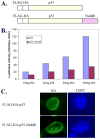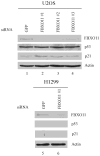FBXO11 promotes the Neddylation of p53 and inhibits its transcriptional activity
- PMID: 17098746
- PMCID: PMC3690493
- DOI: 10.1074/jbc.M609001200
FBXO11 promotes the Neddylation of p53 and inhibits its transcriptional activity
Abstract
The p53 tumor suppressor is regulated by post-translational modification, including ubiquitination, phosphorylation and acetylation. It has previously been shown that the ubiquitin ligase Mdm2 also promotes the conjugation of Nedd8, a ubiquitin-like protein, to p53, inhibiting its transcriptional activity. We report the identification of FBXO11, a member of the F-box protein family and a component of the Skp1.Cullin1.F-box (SCF) complex, as a new p53-interacting protein. We show that FBXO11 promotes the neddylation of p53 both in vitro and in vivo. In addition to the C-terminal lysine residues, FBXO11 can also promote Nedd8 conjugation to Lys-320 and Lys-321, and neddylation of p53 leads to suppression of p53 function. This is consistent with recent studies showing that a lysine to arginine mutation at Lys-320 significantly enhances p53 function, although Lys-320 was originally identified as an acetylation site involving PCAF-mediated activation of p53. Our study provides an example of an F-box protein acting as an adaptor protein that can mediate the neddylation of a non-cullin substrate.
Figures







References
Publication types
MeSH terms
Substances
Grants and funding
LinkOut - more resources
Full Text Sources
Molecular Biology Databases
Research Materials
Miscellaneous

